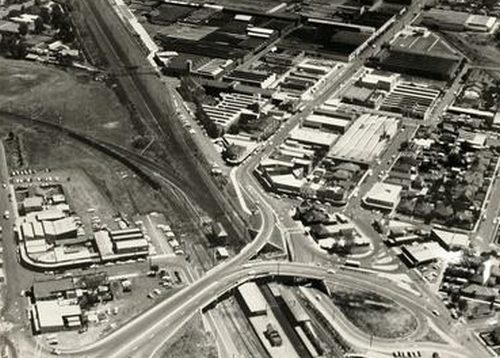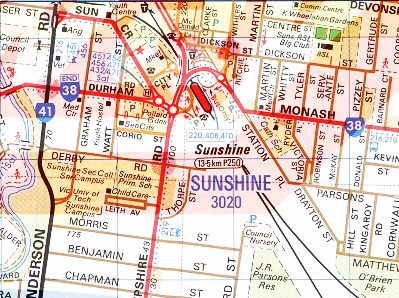This is the story of Sunshine station, and how a railway junction created in the 1880s became the meeting point it is today.
The early years
The story starts in 1860 when the Melbourne to Bendigo railway opened.
However the trigger for the development of Sunshine was the opening of the direct Melbourne to Ballarat railway in 1889, which met the Bendigo line south of Braybrook.
A township called ‘Braybrook Junction‘ was soon established at the railway junction, and in 1906 industrialist H.V. McKay moved his Sunshine Harvester Works to the new township, expanding it to become the largest manufacturing plant in Australia.
And by 1914 increasing traffic saw a new 80 lever signal box erected to direct trains.
As well as a footbridge at the Hampshire Road level crossing.

Charles Daniel Photograph, SLV H2016.33/102
The railway divided Sunshine in two.

1942 Morgan’s Official Street Directory, map 59 and 60
But steam trains still ruled the rails.
Enter grade separation
In 1957 approval was given to construct a standard gauge railway between Melbourne and Wodonga, paralleling the existing broad gauge railway to remove the break of gauge between Victoria and New South Wales. A route via Sunshine was chosen, since adding a fourth track through the Hampshire Road wasn’t an option, the level crossing was grade separated.

VPRS 12903/P1, item Box 681/53
Ready for the running of the first ‘through’ standard gauge train.
For rail passengers the only change was the pedestrian subway used to access the station platforms.

Through ’62: Victorian Railways
But motorists were given a new web of new roads allowing them to fly through the middle of the Sunshine.
Leaving the shops surrounded by speeding cars.
Including the Sunshine post office.

Massey Ferguson collection, item MM 118013
Towards a place for people, not cars
By the 1990s it was realised that a shopping strip full of hooning cars isn’t the nicest place to visit, so moves were made to reclaim the tangle of roads for people.
1994 seeing a new bus interchange created outside the station.
Located where the post office once was.
It was expanded further in 2000, occupying the space between Dickson Street and the station.
With the roads beneath Hampshire Road turned to buses only.
But the station was the same as before.
A rickety timber shack.
Regional Rail Link
After years of proposals for extra tracks between Sunshine and the city, in 2009 the ‘Regional Rail Link’ project was given the go ahead.
Sunshine station was rebuilt from the platform up.
The bus interchange on the north-east side of the station upgraded.
And the bus only ramps beneath Hampshire Road turned over to pedestrians.
Leaving us with the scene seen today.
But the Hampshire Road bridge? It’s still there today.
Will the Melbourne Airport rail link and the ‘Sunshine Super Hub‘ change this – I wouldn’t hold my breath.
Footnote: the signal box
The 80 lever signal box was commissioned at Sunshine in 1914.
The mechanical interlocking remained in service until 1996, when it was replaced by an Solid State Interlocking. This interlocking was itself replaced in 2014, with the signal box being closed in 2016 when control was transferred to the Metrol train control centre.
Sources























What will become of the signal box in the long term. Surely it must be preserved in some form?
The signal box at Sunshine is only on the local Heritage Overlay.
https://vhd.heritagecouncil.vic.gov.au/places/106123/
Unfortunately a common fate for disused signal boxes is to sit there until they get burnt down – like the one on McArthur Street in Ballarat back in 2012.
Occasionally they get restored – disused signal box at Ringwood was relocated to the station forecourt when upgrade works needed the land it stood on.
But LXRA bulldozed the signal box at Coburg to make way for their level crossing removal project.
A big wait and see is the redevelopment of Sunshine as a Hub with the mooted Airport rail link. https://bigbuild.vic.gov.au/projects/melbourne-airport-rail
It’ll sure be interesting how they fit additional tracks beneath the Hampshire Road bridge.
For Airport Rail, the north end of Sunshine to the junction north of Albion station/Ballarat Rd is more likely to be where the extra track issues arise. Sunshine is more likely to get upgraded for Melton/Wyndham Vale electrification to grade separate the junction to avoid a mass of conflicting movements.
1994 the upgrade to interchange was for just the Westrans and then Metbus routes. The pre 2014 bus interchange didn”t open till 2000 when Sita routes moved across to the East Side
If look closely at first 2009 pics you see the 2 408 stops(with brick work) they are from 1994 upgrade while other bus bays are from 2000 upgrade
Thanks for that – I’ve updated the post.